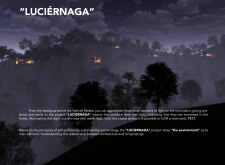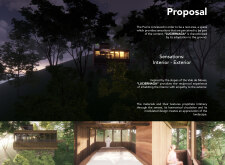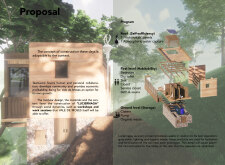5 key facts about this project
The primary function of the project is to serve as a retreat for visitors seeking respite from urban life. It features modular pods that can adapt to different users' needs, creating an environment conducive to relaxation and rejuvenation. The layout includes specific areas for rest and cleanliness, allowing for a focused and functional use of space. The structure promotes a sustainable lifestyle through various eco-friendly practices, including renewable energy generation and water management systems.
Sustainable Materiality and Construction Techniques
This project emphasizes sustainability through innovative material choices and construction methods. The use of rammed earth for the walls provides excellent thermal performance while blending into the surrounding landscape. Wood serves as a primary material for interiors, promoting warmth and a natural aesthetic. The incorporation of glass elements facilitates abundant natural light, enhancing the indoor environment and offering expansive views of the landscape.
Moreover, the project employs two photovoltaic panels on the roofs of the pods and a water capture system that collects atmospheric moisture. These features contribute to the self-sufficiency of the retreat. The architectural design also includes a dry toilet system, which ensures effective waste management and supports the ecological objectives of the project.
Integration with Natural Landscape
A defining aspect of the "LUCIÉRNAGA" project is its integration with the natural landscape of the Vale de Moses. The design strategically places the modular pods along the contours of the terrain, minimizing disruption to the existing ecosystem. This approach enables natural ventilation and passive heating and cooling strategies, reducing reliance on artificial energy sources.
The project promotes an architectural vocabulary that values ecological sensitivity and community involvement. By employing modular construction methods, the design allows for local participation in building processes, thus reinforcing community ties while adhering to sustainable practices. This community engagement aspect distinguishes "LUCIÉRNAGA" from typical architectural projects, forging a deeper connection between the inhabitants and their environment.
For more insights into the "LUCIÉRNAGA" project, including architectural plans, architectural sections, architectural designs, and architectural ideas, interested readers are encouraged to explore the full project presentation. This resource provides detailed information on the innovative approaches and sustainable practices that define this architectural endeavor.


























